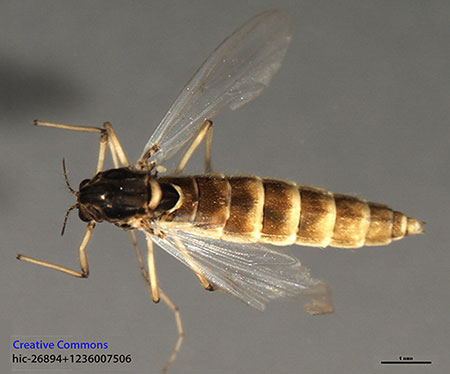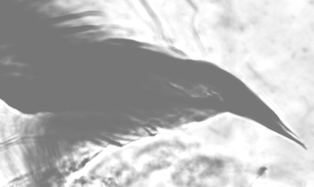Species i. C. atrella (Townes, 1945)C. nr. anthracinus - Butler et al. (1995) For the C. atrella of Hitchcock and Anderson (1968) - see C. quinnitukqut In BOLD Bin: BOLD:AAG5507 Adult: Wing length 4.1 mm, AR 3.9, anterior LR 1.35, body slender. Blackish brown; wing vein r-m slightly darker, legs brown, foretarsis with long sparse beard. Frontal tubercles small, clypeus of medium size.  Male terminalia of C. atrella (left) with superior volsella (right) Genitalia similar to that of C. decorus but anal point narrower and Superior Volsella shorter and stouter; Inferior volsella reaching beyond the end of the anal point to about the middle of the gonostyle, which narrows relatively gently over distal third. Female: Not described, but some characters from a photograph in BOLD database:  Pupa: pupal spur with about one or two major spines, but may be two more smaller lateral spines.  Pupal spur of C. atrella Larva a small to medium plumosus type (len. female abt 9.4-16.7 mm; male 10.4-11.4 mm), ventral tubules moderately long (ant. 0.84-2.9 mm; post. 0.95-3.45 mm) with posterior pair generally longer. Posterolateral tubules well developed, 200-400 µm. Anal tubules relatively long, often partially bilobed, dorsal and ventral pair approximately the same size, length about 633-660 µm, and 3.7 to 4.2 times longer than wide. Cytology: 4 relatively short polytene chromosomes with thummi arm combination, AB, CD, EF, G. atrA2: 1a - e, 8 - 9, 1f - 2c, 10 - 12, 3 - 2d, 7 - 4, 13 - 19 atrB1: Puff (group 7) generally not developed, but is near distal end of arm. atrC1: 1 - 3, 8 - 11c, 4a - i, 6b - 5, 15 - 11d, 6gh, 17a - 16, 7d - a, 6f - c, 17b - 22 atr C2: 1 - 3, 4g - a, 11c - 8 4b - i, 6b - 5, 15 - 11d, 6gh, 17a - 16, 7d - a, 6f - c, 17b - 22 atrC3: 1 - 3, 8 - 11c, 4a - i, 6b - 5, 12 - 15e, 11h - d, 6gh, 17a - 16, 7d - a, 6f - c, 17b - 22 atrC4: 1 - 3, 4f - a, 11c - 8, 4g - i, 6b - 5, 12 - 15e, 11h - d, 6gh, 17a - 16, 7d - a, 6f - c, 17b - 22 atrD1: 1 - 3, 11 - 18d, 7 - 4, 10 - 8(7e), 18e - 24; ie. as in longistylus atrD2: 1 - 3, 17 - 11, 18a - d,7d - 4, 10 - 7e, 18e - 24 atr D3: 1 - 3e, 5d - 4, 10e - a, 7 - 5e, 11 - 15d, 18d - 15e, 3fg, 9 - 8, 18e - 24 atrE1: 1a - 3e, 10b - 3f, 10c - 13g; ie. as in aprilinus atrE2: 1a - e 10b - 9, 7 - 8, 6 - 3f, 10c - 13 atrF1: 1a - f, 9 - 3c, 14 - 10, 1g - 3b, 15 - 23 atrF2: 1a - f, 9 - 3c, 14h - a, 16 - 15, 3b - 1g, 10 - 13, 17 - 23 atrF3: 1a - f, 9 - 5d, 13 - 14, 3c - 5c 12 - 10, 1g - 3b, 15 - 23 atrF4: approx: 1a - f, 9 - 6, 15 - 16, 14a - h, 3c - 5, 3b - 1g, 10 - 13, 17 - 23 ie. inv of F2 atrG1: Short with terminal nucleolus and BR near other end Molecular: There is a large amount of MtCOI barcode sequence in the BOLD database. Found: Type locality - Reno, Nevada (Townes 1945) Prairie sloughs, larger pools, and lakes in depths of 0.09-13.5 m. It is possible that Townes' type series of C. atrella was a mixture of two species: one with a southern distribution e.g. the type from Reno, Nevada; and the other a more Boreal species, e.g the paratypes from Alberta and Manitoba. This second species is not conspecific with C. ?nr. atrella (below). Previously Species Ea of Butler, and then C. nr. anthracinus of Butler et al. (1995). Polytene chromosomes fully described by Martin et al. (2006). Some of the differences of morphological characters from different localities may be related to the different combinations of chromosome sequences noted between populations, some of which appeared to be related to the depth of the habitat (Martin et al. 2006). It seems likely that C. atrella is the sister species of C. degelenus Seisebaev, Bakhtin & Siirin (2001) which is known from Kazakhstan. |
Modified: 2 May 2025
Access: Unrestricted
Copyright © 2000-2025, Jon Martin.